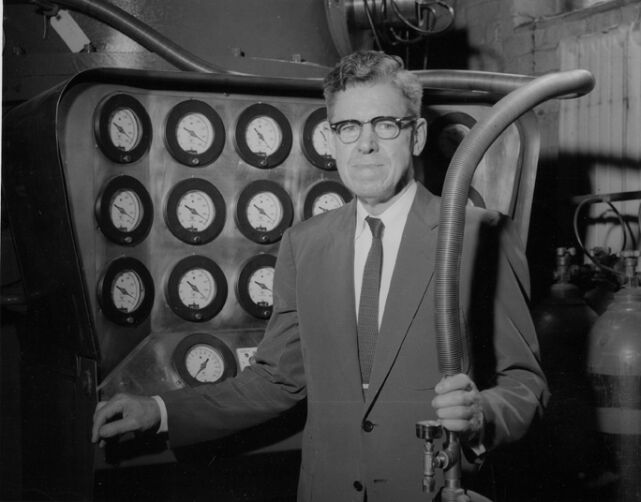Dr. Samuel C. Collins, Professor Emeritus of the Massachusetts Institute of Technology, internationally known as the father of practical helium liquefiers and founder of the MIT Cryogenic Engineering Laboratory, died on June 19, 1984 in George Washington University Hospital, Washington, DC.

In 1946, Dr. Collins and his colleagues at MIT built what became know as the Collins Helium Cryostat. The device provided for the first time reliable, relatively in expensive and adequate supplies of liquid helium. His invention was of great interest to physicists because it opened the door to extensive experimental low-temperature physics.
The device conceived by Professor Collins was simple in design, consisting of a two-cylinder engine with the cylinders arranged so that the cold exhaust of one cools the intake gas of the other. This makes it possible to produce liquid helium without the aid of external coolants.
Professor Collins' achievement revolutionized cryogenics. Before the Collins Helium Cryostat, every low-temperature laboratory had to build its own low-temperature apparatus using liquid hydrogen, a devious and dangerous material. Because every device was unique and expensive, there were only a few cryogenic laboratories throughout the world. The Collins Cryostat was mass-produced by Arthur D. Little, Inc., and by the mid-1960s, there were 250 of them at work in laboratories throughout the world. Professor Collins established the Cryogenic Engineering Laboratory at MIT in 1949 and was the key figure in its research for many years.
Dr. Howard O. McMahon, a colleague both at MIT and A.D. Little, said that Professor Collins "made the practice of the science of cryogenics possible in many universities." It became possible for a university to buy a liquefier for $2000 and they were in business. "He was a wonderful man, extremely modest. His ears would be burning if he could hear me. But he was beloved by everyone who met him, students especially."
Professor Collins was also known for developing - in collaboration with Dr. Ernest M. Barsamian, a surgeon at the Veterans Hospital in West Roxbury, a suburb of Boston - a compact heart-lung machine. The device, completed in 1964, was small enough to fit into the trunk of a car. Machines in use then were desk size and required several hours to set up. Professor Collins' machine could be placed in service quickly and needed only one quart of blood to begin operating. His development made it possible to use heart-lung machines at accident scenes, in ambulances, or during military operations.
Dr. Collins was born on September 28, 1898, in Democrat, Kentucky. He received bachelor's and master's degrees fro the University of Tennessee in 1920 and 1924 and the Ph.D. in 1927 from the University of North Carolina.
He taught at Carson-Newman College, the University of Tennessee, Tennessee State Teachers College, and the University of North Carolina before joining MIT in 1930 as a research associate in physical chemistry. He was in the Department of Chemistry until World War II. During the war, he developed an airborne oxygen generator, which was the first use of the reversing heat exchanger process for air separation and high purity oxygen production. After the war, he joined the Department of Mechanical Engineering and was promoted to professor in 1949.
Among his many honors were the 1951 Wethrill Medal of the Franklin Institute in Philadelphia; the 1958 Kamerlingh Onnes Gold Medal of Dutch Science; the Rumford Medal of the American Academy of Arts and Sciences, awarded in 1965; and the gold medal of the American Society of Mechanical Engineers, presented in 1968. He was a fellow of the American Academy of Arts and Sciences and was made a fellow of the National Academy of Sciences in 1969. He was the first recipient, in 1965, of the special award established by the Cryogenic Engineering Conference in his honor, the Samuel C. Collins Award, for outstanding contributions to Cryogenic Technology. Dr. Collins held honorary degrees fro the University of North Carolina and St. Andrews University, Scotland.
He is survived by his wife, who lives in Washington, DC. Professor Collins was buried in Tennessee.
|
|